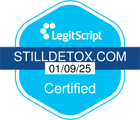What Is Phenibut Withdrawal? Understanding the Basics
Phenibut (β-phenyl-γ-aminobutyric acid) is a central nervous system depressant developed in the 1960s in Russia, where it’s prescribed for anxiety and insomnia. In the U.S., it’s not FDA-approved but is available online as a “nootropic” or supplement. It mimics GABA, calming brain activity, but regular use builds tolerance, leading to dependence. Phenibut withdrawal occurs when someone stops after consistent use, triggering a rebound of neurological hyperactivity. A 2019 Current Psychiatry Reports review notes its rising misuse, often at doses far above the 250-500 mg recommended range 1.
Why Phenibut Leads to Withdrawal: The Science
Phenibut’s withdrawal stems from its action on GABA receptors, primarily GABA-B, and to a lesser extent GABA-A, mimicking natural inhibitory signals. Chronic use downregulates these receptors—reducing their sensitivity—meaning the brain relies on phenibut to maintain calm. Phenibut acts on the brain in a similar way to pregabalin. Stopping it causes a surge in excitatory neurotransmitters like glutamate, leading to withdrawal. A 2020 Psychopharmacology study showed phenibut’s prolonged receptor binding mimics benzodiazepines, explaining its potency and withdrawal severity 2.
What drives phenibut withdrawal biologically? It’s the receptor adaptation from high doses—sometimes 20 times the therapeutic amount.
Phenibut’s Legal Status: Availability and Regulation
Phenibut occupies a gray legal area, contributing to its withdrawal risks. In Russia and some Eastern European countries, it’s a prescription drug for anxiety and sleep disorders. In the U.S., it’s unscheduled—not a controlled substance—but not FDA-approved for any use, sold as a dietary supplement online. This loophole fuels easy access, with doses ranging from 250 mg to bulk kilograms. The FDA issued a 2019 warning about its risks, citing adverse events like sedation and coma 3, yet enforcement remains lax.
What is phenibut withdrawal’s link to its status? It’s horrifying that it is used in dietary supplements, and people can order it freely, often escalating use without oversight, which drives the dependence we treat.
Symptoms: What Phenibut Withdrawal Looks Like
Phenibut withdrawal mirrors benzodiazepine or alcohol withdrawal due to its GABAergic effects. Symptoms emerge 4-10 hours after the last dose, given its 5-6 hour half-life, including anxiety, agitation, insomnia, and tremors. Severe cases may feature hallucinations, delirium, or seizures. A 2018 Journal of Clinical Psychopharmacology report documented psychosis and agitation lasting days in a high-dose user 4.
What is phenibut withdrawal’s presentation? It combines physical symptoms—sweating, rapid heart rate—with psychological distress, requiring prompt medical attention.
Timeline: How Long Does Phenibut Withdrawal Last?
The phenibut withdrawal timeline depends on dosage, usage duration, and individual factors. Acute symptoms peak within 1-3 days, lasting about a week for moderate users (1-3 g/day). Heavy users (5-10 g/day) may endure symptoms for 2-3 weeks, with post-acute withdrawal (PAWS)—mood swings, fatigue—persisting months. A 2023 Clinical Neuropharmacology case required 24 weeks for stabilization 5.
Risks and Complications: Why Phenibut Withdrawal Matters
Phenibut withdrawal poses significant risks, including seizures from abrupt cessation, driven by GABA receptor changes. A 2019 Biomolecules and Biomedicine review identified 22 cases needing ICU care for agitation or psychosis 6. Combining phenibut with alcohol or sedatives—common locally—increases overdose or withdrawal severity. The FDA has flagged its potential for dependence and sedation-related harm 3.
Recovery at Still Detox: Managing Phenibut Withdrawal
Detox involves tapering—often with baclofen (10 mg per gram of phenibut)—under supervision to reduce symptoms. Benzodiazepines like lorazepam manage acute anxiety or seizures, while Cognitive Behavioral Therapy and group support target triggers. A 2018 Case Reports in Psychiatry study validated baclofen’s role in tapering 7. Holistic care—nutrition, exercise—bolsters recovery.
Our Boca Raton team ensures safe detox and sobriety. Call (561) 556-2677 if phenibut withdrawal is an issue—Still Detox is here.








